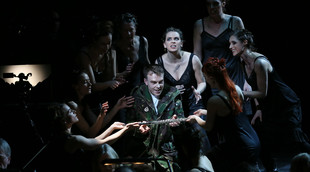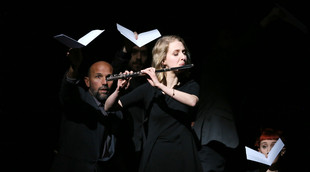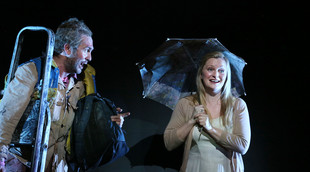 © Donald Cooper
© Donald Cooper
The Magic Flute is Mozart’s final opera, and takes the form of a Singspiel that combines singing with spoken dialogue. In it, the Queen of the Night persuades Prince Tamino to rescue her daughter Pamina from captivity under the high priest Sarastro, who she claims is evil. As Tamino goes about his quest, however, and falls in love with Pamina, he learns that things are the other way around. The Queen of the Night represents the forces of darkness, while Sarastro’s community stands for high ideals and enlightened values, leading Tamino to seek to join it. As a result, he and Pamina, separately and then together, undergo a series of trials of initiation. These are focused less on revealing brute strength than moral resolve and mental courage, and end in triumph with the Queen and her cohorts vanquished. Some comedy is also introduced in the form of the bird catcher, Papageno, who accompanies Tamino on his quest and fails the trials completely, although he is rewarded anyway with the hand of his ideal female companion Papagena.
Mozart and his librettist, Emanuel Schikaneder, were both Freemasons, and the work is noted for its Masonic elements and Enlightenment philosophy. It premiered on 30 September 1791, just a few months before Mozart died, not at Vienna’s Burgtheater, but at Schikaneder’s own Freihaus-Theater auf der Wieden, where by November 1792 it had already notched up a hundred performances. This venue was as famed for its fairytales and comedies as its Goethe, and the production included sixteen set changes as well as real lions, monkeys and serpents. As a result, while the piece has never seriously gone out of fashion, it did in nineteenth century Germany become caught between the advocates of Italian and Romantic opera, and bridging the gap between its fun and religious elements, its obvious magic and deeper symbolism, has remained a problem until this day.
However, this 2013 production from Complicite’s Simon McBurney, which represents a joint venture between English National Opera, De Nederlandse Opera and the International Festival of Lyric Art, succeeds in making sense of the ‘jumble of farce and sublimity’ by playing up the different aspects of the opera for all their worth. It is also a production that has grown stronger with each revival so that while six years ago the deliberately theatrical elements felt somewhat at loggerheads with the more serious sides to the work, now they actually succeed in highlighting the essential nature of the piece.
McBurney places unique emphasis on the notions of the visual and aural. The orchestra pit is raised so that the players are clearly visible, while soloists are frequently ‘retrieved’ from it to play the magic flute and bells for the characters. A camera lies to one side, with images or writings that its operator creates being projected live onto the stage. On the other side stands a sound booth from which a technician generates additional noises and effects. During the Overture, which begins with the house lights up, this pair stand in front of the conductor and audience before moving to their respective positions, which in itself shows how sight and sound, the two ultimate pillars of opera, are themselves taking centre-stage.
Actors jump about the stage flapping sheet music to create birds, while Papageno carries a stepladder throughout the opera to enable him to reach different platforms in Michael Levine’s set, and thus bring the whole notion of staging a drama to the fore. Cameras are cast over the stalls projecting live images of the spectators onto the stage, and Papageno sings ‘Ein Mädchen oder Weibchen’ while clambering through the front row of the auditorium and attempting to chat up the technician in the sound booth!
If many actions bring out the comedy, however, Finn Ross’s video projections that portray the serpent and the journeys through fire and water are deadly serious in their accomplishment, while other effects prove highly disconcerting. The Queen of the Night becomes a wheelchair bound Miss Havisham-style hag, with the fact that she still carries a certain air of sensuous elegance hardly making her any less frightening. The three Child Spirits are also paradoxically and disturbingly portrayed as Gollum-like old men with sticks.
There are also many subtle touches. While some of the images that the video illustrator creates are projected live, there are others that have already been prepared but he makes look as if he is creating in the moment, which highlights the whole concept of illusion in the opera. When he chalks up ‘Fire’ (for real) to introduce the journey through fire he then rubs it out in such a way as to suggest that the surrounding flames are consuming it. During Act I’s ‘Das klinget so herrlich’ a menagerie of animals are introduced using Eadweard Muybridge images, which are made to look as if they are moving across a huge electronic book whose pages turn.
This is conductor Ben Gernon’s English National Opera debut, and he delivers a highly compelling account of the score, in which momentum is maintained throughout, and a generally sumptuous sound is tempered by a sharp delineation of line. Rupert Charlesworth is a very strong Pamino, with his tenor sounding quite light and yet being very full in tone, so that the resulting sound is extremely pleasing as it achieves the best of both worlds. His voice is also well matched to that of Lucy Crowe who reprises her role of Pamina from 2016 and, once again, reveals a soprano that possesses a radiant ethereal quality, and never once wavers across the evening. The pair also make the characters feel very engaging, and when Pamina sings ‘Ach, ich fühl’s’ Tamino does not appear as some statuesque presence, but genuinely looks as if he is being torn to pieces inside as he is forced to ‘shun’ her.
Brindley Sherratt is luxury casting as Sarastro as he hands the character exactly the right air of dignity, while his deep and rich bass really comes to the fore in ‘In diesen heil’gen Hallen’. Julia Bauer as the Queen of the Night delivers a very fine performance of ‘Der Hölle Rache’, with her coloratura simultaneously feeling highly intriguing and immaculately controlled. Papageno was played here in 2013 by Roland Wood as a blustery, cheeky chancer, and by Peter Coleman-Wright in 2016 as a far more befuddled and sad-eyed figure. Thomas Oliemans combines the best features of both approaches in his own portrayal so that it feels extremely balanced and highly effective, while Daniel Norman and Jonathan Lemalu stand out as Monostatos and the Speaker of the Temple respectively. Susanna Hurrell, Samantha Price and Katie Stevenson are also in excellent vocal shape as the Three Ladies, as are Guillermo Fernandez-Aguayo Martin, Richard Wolfson and Nao Fukui (alternating with Alex McSweeney, Zeb Jenkins and Sasha Rose) as the Child Spirits.
By Sam Smith
The Magic Flute | 14 March – 11 April 2019 | London Coliseum
the 18 of March, 2019 | Print



Comments